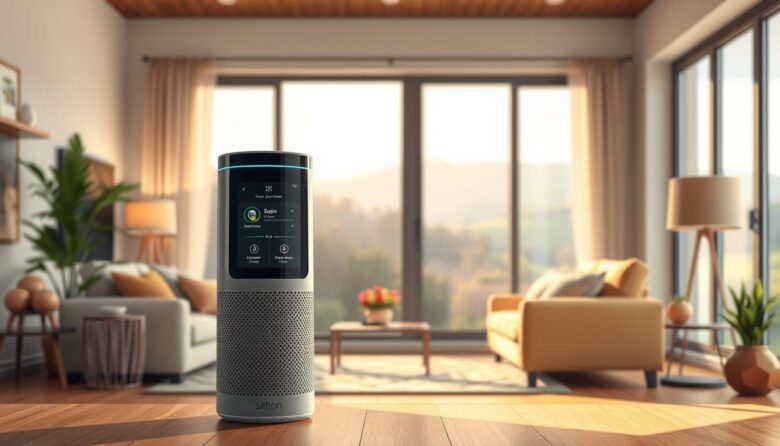Imagine controlling your lights, playing music, or setting reminders without lifting a finger. Smart speakers and displays now make this possible through simple voice commands, creating an easier way to manage daily tasks. For older adults, these devices eliminate the frustration of tiny buttons or confusing apps.
Three major options stand out: Amazon’s Alexa, Google Assistant, and Apple’s Siri. While each has unique strengths, Amazon and Google devices often work best for seniors. The fifth-generation Echo Dot ($50) offers clear sound in a compact design, while Google’s Nest Hub Max ($230) adds a helpful screen for video calls and visual reminders.
These tools do more than play news or weather updates. They connect to smart home gadgets, adjust thermostats, and even call family hands-free. Affordable models mean you don’t need to overspend – basic features start at $50. Best of all, setup requires minimal tech skills.
Key Takeaways
- Top devices include Amazon Echo Dot, Google Nest Audio, and Nest Hub Max
- Hands-free control reduces physical strain during daily tasks
- Prices range from $50 to $230 for premium displays
- Works with lights, thermostats, and entertainment systems
- Simplifies communication through voice calls and reminders
Understanding the Role of Voice Assistants in Senior Living
Staying independent while managing daily tasks becomes simpler with modern voice technology. These tools adapt to your needs, turning complex actions into effortless conversations. Whether adjusting room temperatures or checking the weather, smart home devices respond instantly to spoken requests.
Why Voice Technology Matters for Seniors
Physical challenges like stiff joints or fading eyesight make traditional gadgets frustrating. With a voice assistant, you control lights, locks, or thermostats using natural speech. No more squinting at screens or struggling with buttons. This reduces fall risks and keeps routines flowing smoothly.
These systems also learn your habits. Lights dim automatically at bedtime, and thermostats adjust when you say, “I’m cold.” For those living alone, quick access to music or family calls combats loneliness. Medication alerts ensure you never miss a dose.
How Smart Home Devices Enhance Daily Routines
Smart home devices handle repetitive tasks so you focus on what matters. Say “good morning” to raise blinds and brew coffee. Voice commands turn off forgotten lights, saving energy and money. Secure your space by checking door locks without leaving the couch.
Family members appreciate remote monitoring features. They can confirm you’re safe or adjust settings if needed. It’s like having a helpful companion who never tires—all powered by your voice.
Exploring Voice-Activated Home Assistants
What if your living space could respond to your needs before you even finish asking? Modern voice-controlled systems turn this idea into reality. They listen, learn, and act—transforming how you interact with everyday technology.
The Advantages of a Hands-Free Experience
These tools shine when your hands are busy. Imagine stirring soup while asking for a timer or folding laundry as lights adjust to your preference. Simple phrases like “dim the lamps” or “play classical music” keep tasks flowing smoothly.
No need to repeat yourself. Today’s systems recognize accents and adapt to speech patterns. Ask “What’s tomorrow’s forecast?” followed by “Will I need an umbrella?” without restating details. They connect context effortlessly.
Multi-step commands simplify routines. A single “Good morning” trigger can open blinds, share news headlines, and start your coffee maker. This reduces physical effort and mental load—ideal for those with limited mobility.
Background noise rarely disrupts interactions. Advanced microphones filter out distractions, ensuring clear communication. Whether hosting grandkids or watching TV, your requests stay front and center.
Key Features to Seek in a Senior-Friendly Voice Assistant
Choosing the right tools can transform how you manage daily tasks. Look for features that adapt to your lifestyle while keeping technology simple. Start by checking compatibility with services you already use—like music apps or smart thermostats. This avoids frustrating “why won’t it work?” moments.
Clear sound matters. A good device delivers crisp responses even at high volumes without distortion. Pair this with bright indicator lights that show when it’s listening. Visual cues help confirm your command was received, especially if hearing changes with age.
Skip complicated setups. The best options work right out of the box—just plug in and follow basic voice prompts. No app downloads or tech jargon required. If you share your space, find models that recognize different voices. This keeps calendars and reminders separate but organized.
Natural speech patterns make interactions smoother. Look for adjustable response speeds so information comes at your preferred pace. Finally, easy-access privacy controls let you decide what data gets stored. Your comfort and security should never feel like afterthoughts.
Top Smart Speakers and Displays for Everyday Use
Finding the right tech companion can make daily routines simpler and more enjoyable. Let’s explore three standout options that balance clear communication, visual clarity, and user-friendly design.
Smart Speaker Recommendations for Seniors
The Google Nest Audio ($75) shines with its pillow-shaped design and room-filling sound. Its mid-range tuning ensures every weather update or medication reminder comes through crisp and clear. The fabric exterior blends into living spaces while resisting dust – perfect for low-maintenance setups.
For budget-conscious users, the Amazon Echo Dot (5th Gen) packs impressive audio into its compact frame. At $50, it handles voice commands reliably and pairs easily with existing smart home gadgets. The glowing light ring provides visual feedback when activated.
Best Smart Displays for Visual Ease
The Google Nest Hub Max ($230) combines a 10-inch screen with voice control. Large text and bold icons make checking calendars or video-calling family effortless. Bonus: It displays rotating photo albums when idle, turning practical tech into a memory showcase.
All three devices prioritize speech recognition over background noise. Their straightforward setup processes mean you’ll be asking for recipes or adjusting thermostats within minutes – no tech degree required.
Budget-Friendly Options for Voice Assistant Devices
Quality voice technology doesn’t need to drain your savings. Several compact devices deliver full functionality under $75, letting you enjoy modern conveniences without financial stress. The key lies in choosing models that balance performance with simplicity.
Amazon’s Echo Dot (5th Gen) stands out at $50. This palm-sized speaker packs crisp audio for music and clear responses to questions. Its rounded design fits neatly on countertops or bedside tables, blending into any room. You get all core Alexa features – smart home control, weather updates, and medication reminders – identical to larger models.
Google’s Nest Mini offers similar pricing at $49 but faces availability issues. Many colors remain out of stock, and its 2021 hardware feels outdated compared to newer options. For immediate use, the Echo Dot provides better reliability and consistent updates.
These budget-friendly devices prove you don’t need premium prices for essential tools. Their smaller size reduces intimidation for first-time users while supporting the same commands as high-end versions. Whether testing the waters or building a starter system, this choice keeps independence affordable and accessible.
Enhancing Home Security with Smart Devices
Peace of mind starts at your front door. Modern security tools now let you protect your space through simple voice interactions and automated routines. These systems blend discreetly into your living environment while offering robust protection.
Integrating Smart Locks and Security Cameras
The Schlage Smart Wifi Deadbolt redefines entry management. Instead of fumbling with keys, say “unlock the front door” to welcome guests. Family members receive instant alerts when doors open, letting them monitor arrivals remotely.
Video doorbells add another layer of control. See who’s outside through your smart display and communicate without moving from your chair. Packages get safer deliveries, and unfamiliar visitors stay screened.
Cameras work seamlessly with voice commands. Ask “show me the porch” to check surroundings instantly. Motion sensors trigger automatic recordings, while scheduled lights create the illusion of activity when you’re away.
These home devices build consistent safety habits. Doors lock themselves at bedtime, and alarms activate with sunset. For seniors prioritizing independence, this blend of vigilance and simplicity keeps worries at bay.
How to Seamlessly Integrate Voice Assistants with Your Home
Building a connected living space starts with smart pairing strategies. By linking devices through a central system, you create a network that responds reliably to your needs. This approach minimizes confusion and maximizes convenience.
Pairing Devices for an Integrated System
Begin with one core device like a smart speaker. The Google Home app simplifies adding compatible gadgets – lights, thermostats, or locks. Its visual interface guides you through each step without overwhelming menus.
Stick to one ecosystem for smoother integration. Google, Amazon, or Apple devices work best together. This avoids compatibility headaches and keeps controls unified. Most modern tools auto-detect nearby devices, suggesting pairings in seconds.
Set up takes three steps: download the manufacturer’s app, connect to Wi-Fi, and link accounts. Voice assistants then recognize new additions automatically. Test with simple commands like “turn on the lamp” before creating multi-device routines.
Customize phrases to trigger actions across your home. Say “movie night” to dim lights and lower blinds. These personalized shortcuts reduce effort while making technology feel intuitive. Regular updates keep your system secure and responsive.
Setting Up Your Voice Assistant: Tips and Tricks
A well-configured assistant adapts to your lifestyle, not the other way around. Start by speaking naturally during setup – this helps the device learn your voice patterns and accent. Clear enunciation during initial training improves response accuracy over time.
Configuration and Personalization Tips
Set preferred news sources, weather locations, and music genres early. These choices make daily interactions feel tailored to you. Adjust volume and speech speed in settings if responses feel too quiet or rushed.
Create profiles for multiple users if sharing the device. This keeps calendars, reminders, and preferences separate but organized. Enable visual cues like blinking lights to confirm your voice commands were heard.
Optimizing Voice Commands for Efficiency
Bundle actions into phrases like “Start my day” to trigger lights, news updates, and coffee makers simultaneously. Use conversational language instead of memorizing technical terms – say “warm up the bedroom” rather than “set thermostat to 72°.”
Practice simple tasks first: setting timers or asking for weather. Gradually add smart home controls as confidence grows. Regular use helps the system refine its understanding of your unique needs.
Voice Commands That Simplify Routine Tasks
Mastering a few key phrases turns complex tasks into simple spoken requests. Start your day by saying, “Good morning” to get weather updates and calendar reminders. Your device will share news headlines while coffee brews – no screens required.
In the kitchen, try “set a timer for 15 minutes” or “convert two cups to milliliters.” These voice commands keep hands free for cooking. Ask for recipe steps aloud to avoid touching devices with messy fingers.
Need relaxation? Say “play Frank Sinatra” or “read my mystery novel.” Music and audiobooks start instantly through connected apps. No more squinting at tiny buttons or navigating menus.
Health stays on track with “remind me to take my pills at 8 AM.” Gentle prompts encourage hydration or stretch breaks throughout the day. Over time, you’ll discover new phrases that fit your unique rhythm – technology adapts to you.



